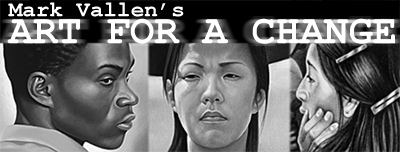The Architecture of Submission
Cultural democracy is part of the structure of any truly democratic society, and like political democracy, it derives its strength solely from the people. The creation, propagation, and accessibility of the arts not only helps to promote democratic values – it is vital to them. However, participatory and community based cultural democracy is never a given, it is something we must persistently strive towards. Its ideals and principles are severely compromised when any one faction attempts to monopolize the cultural sphere.
There are some who fondly dream of culture transformed into a cartel, and they may be interested in a Los Angeles forum titled, Picture I.D!: Placing, Naming, Shaping.
The Foundation for Art Resources (FAR), began 27 years ago in Los Angeles as an organization concerned with supporting work by artists “who challenge and expand the boundaries of established notions of art and art making within the Los Angeles region.” Composed of artists, curators, and designers, FAR over the years has been involved in a number of projects, including Art-Talk-Art, which the organization touts as the longest running academic series of its kind in LA.
On June 9th, 2005, FAR will present the third and final panel discussion in its 2004/2005 Art-Talk-Art program: Picture I.D!: Placing, Naming, Shaping. Held at the Museum of Contemporary Art (MOCA), in downtown LA, the evening’s program is being heralded as an “open conversation” that will be of interest to “artists, architects, designers and anyone concerned with the challenges of doing creative work in the context of contemporary mass culture. Four exceptional panelists lead this interdisciplinary discussion exploring how image and identity are produced and negotiated today.”
In case that isn’t quite clear enough for you… “contemporary mass culture” alludes to the spoon-fed corporate pap we are force fed on a daily basis – drivel that passes for culture. However, I must admit the part about “how image and identity are produced and negotiated today” is refreshingly honest, though still a bit wordy. It would have been so much simpler to just say “trickle down culture” – where the people get what the elites think they should have.
Perhaps you think my judgment of FAR’s Picture I.D! forum too harsh? Fair enough, let’s examine the credentials of the exceptional panelists.
First we have Kristi VandenBosch, president of TBWA Worldwide Tequila, a marketing firm dedicated to understanding “how to connect brands and consumers,” in other words, corporate propaganda. According to FAR’s press release, Ms. VandenBosch continually seeks “new and innovative ways to place brands into environments that elevate their connective nature.” That’s another way of saying despoiling an already blighted urban environment with yet more useless corporate advertising.
Then there’s Jeffery Inaba, who works with corporate clients to “create strategies and designs” for brands, buildings, and cities. His clients include Coca Cola, Nissan, and TBWA/Chiat/Day.
Next in line is Mr. Neil Denari, an architect who has worked at creating luxury offices and facilities for only the best of corporate clients – including rebranding programs for same. Lastly, there’s Miwon Kwon, the only panelist who does not have direct connections to the corporate hierarchy. Kwon is an associate professor in the department of art history at UCLA, and an art critic who writes about contemporary public art and urban spaces.
Still think my judgment of FAR’s forum too severe? Well then, take a look at the topics the panelists will be chatting about, “Is the boundary between product and place eroding or simply being redefined? Brand identity may now apply as readily to individuals and destinations as it does to packaged goods. What does this mean for our understanding of ‘consumption’ and how does it affect practices in art, architecture and advertising?”
Doesn’t it all read like the agenda to a corporate board room meeting? It’s preposterous to assume that those working for multi-million dollar advertising and architecture agencies will be able to speak on behalf of the public interest in a fair and impartial manner. The voices of gentrification, urban blight, centralized power and corporate rule seem to be well represented in this “open conversation” on the direction of public space and culture in Los Angeles… but where are the panelists who represent grass roots community interests? Can architecture beholden to vested private interests expand and deepen the concept of the public commons, or will we simply end up with the architecture of submission?
Inviting artists, architects, and designers to sit and listen to such a lopsided panel is a poor substitute for having failed to enlist their active participation in an honest discussion about public space in an urban environment. But then, perhaps FAR has abandoned its original mission and is content to serve as a recruitment advertising agency for companies who seek “new and innovative ways to place brands into environments.”
Even the sub headline to the forum’s title – Placing, Naming, Shaping – conveys a top down corporate outlook on the subject of culture. It has much more to do with demographics and target markets than concern for a community’s cultural needs or aspirations.
I do not wish to be placed, named, or shaped by advertising agencies, but when entire localities are treated in such a manner democracy and culture are debilitated. The most undemocratic and amoral structures to be found in the world today are corporations whose only modus operandi is the maximization of profits. To believe such institutions can have anything but a deleterious effect upon culture and public space is, to borrow a title from one of FAR’s benefit exhibitions – FAR fetched.


